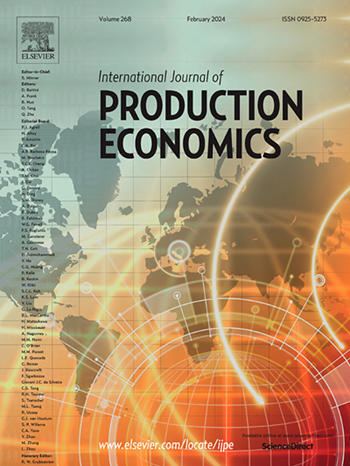供应商的质量改进是否会阻碍竞争买家的联合采购?产品差异化与制造合作的影响
IF 9.8
1区 工程技术
Q1 ENGINEERING, INDUSTRIAL
引用次数: 0
摘要
考虑一个与其合同制造商(CM)竞争的品牌,其中CM有自己的品牌业务。他们的产品需要相同的关键组件(例如,戴尔和华硕都在他们的笔记本电脑上使用英特尔酷睿处理器),但最终会有不同的性能,因为竞争对手的CM通常具有较差的产品设计能力。一个自然的问题是,为了节省成本,将零部件采购订单集中在一起是否有益,如果有益,零部件供应商提高质量的动机是否会受到阻碍。通过对零部件供应商的质量投资、品牌与竞争厂商的制造合作以及下游市场的产品竞争进行权衡,构建了合作竞争的三层供应链模型。我们发现,当品牌商的设计能力劣势有限或显著,导致产品竞争加剧或温和时,品牌商鼓励零部件质量投资,但不鼓励品牌商与竞争品牌商联合采购。供应商认识到品牌的优势需求潜力,在没有品牌和竞争对手CM联合采购的情况下,将CM的批发价格战略性地向上调整,而品牌则向下调整。我们的研究扩展了先前对联合采购的研究,展示了上游供应商如何利用质量投资和批发定价策略来避免买家采购联盟带来的潜在利润损失。本文章由计算机程序翻译,如有差异,请以英文原文为准。
Will supplier's quality improvement discourage competing buyers' joint procurement? Impact of product differentiation and manufacturing cooperation
Consider a brand that competes with its contract manufacturer (CM) where the CM has self-brand business. Their products need the same key components (e.g., Dell and ASUS both use Intel Core processor for their laptops) but eventually have differentiated performances because the competitive CM usually have inferior product design capability. One natural question is whether it is beneficial to pool their component purchase orders for cost saving and if so, whether the component supplier's incentive to improve quality will be discouraged. We build a co-opetitive three-layer supply chain model by formulating the trade-offs among the component supplier's quality investment, the brand and the competitive CM's manufacturing cooperation, and their product competition in the downstream market. We find that when the CM's design capability disadvantage is either limited or significant, leading to intensified or mild product competition, component quality investment will be encouraged, but the joint procurement between the brand and the competitive CM will be discouraged. Recognizing the brand's advantageous demand potential, the supplier will strategically adjust the CM's wholesale price upward, whereas the brand's downward without the joint procurement of the brand and the competitive CM. Our study extends prior research on joint procurement by demonstrating how upstream suppliers can leverage both quality investment and wholesale pricing strategies to avoid potential profit loss from buyer procurement alliances.
求助全文
通过发布文献求助,成功后即可免费获取论文全文。
去求助
来源期刊
CiteScore
21.40
自引率
7.50%
发文量
266
审稿时长
52 days
期刊介绍:
The International Journal of Production Economics focuses on the interface between engineering and management. It covers all aspects of manufacturing and process industries, as well as production in general. The journal is interdisciplinary, considering activities throughout the product life cycle and material flow cycle. It aims to disseminate knowledge for improving industrial practice and strengthening the theoretical base for decision making. The journal serves as a forum for exchanging ideas and presenting new developments in theory and application, combining academic standards with practical value for industrial applications.

 求助内容:
求助内容: 应助结果提醒方式:
应助结果提醒方式:


